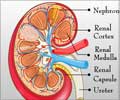- Resources available for preventive care and cost-saving dialysis options are underutilized in most countries
- Countries with higher GDP are able to spend more on dialysis care
- Low-income countries are unable to meet the demand of all patients who require dialysis due to the high volume associated with lack of dialysis units
One in 10 people on this planet have some degree of kidney problem and this incidence is rising around the world. Patients with irreversible kidney damage require renal replacement therapy or RRT is the recommended course of treatment to replace the normal blood filtering function of the kidney. RRT includes kidney transplantation and dialysis - hemodialysis or peritoneal. Of these, transplantation, which involves implanting a healthy donor kidney, is viewed as the most favorable life-extending treatments available as it provides a better quality of life and survival chances to the patients. Dialysis, on the other hand, is a temporary measure to artificially sustain the kidney functions in most patients until they are able to receive a transplant.
Read More..
The Cost Factor
Among patients receiving RRT treatments worldwide, those undergoing dialysis are greater in number owing to lack of organ donors and shortcomings in infrastructure to consider the transplantation option. Dialysis also becomes the choice of treatment for those who are not fit to undergo transplantation. As the number of patients requiring RRTs grows in number, the corresponding healthcare costs involved have also significantly increased. In-center hemodialysis inside a hospital is the highly preferred option by patients from most countries, whereas peritoneal dialysis and dialysis at home are not very popular choices.Every country has opted its own reimbursement systems in order to meet the rising demand of its population. They are working on ways to provide superior healthcare and achieve good health outcomes while being able to minimize the cost involved in doing so. A dialysis reimbursement package may cover a range of components including drugs, physician charges, laboratory services and equipment costs. Comprehensive assessments of how different countries across the globe have been adapting schemes to reimburse the dialysis care costs of their population remains an understudied area. On the other hand, data relating to average dialysis costs incurred by various nations has been extensively published. A research team from University Hospital Ghent, Belgium has attempted a comparative study to understand how various countries fare in optimally using their resources for dialysis care reimbursement.
The Study Design
A team of researchers led by Arjan van der Tol, MD, PhD and Raymond Vanholder, MD, PhD has been able to collect data from around 90 countries to understand the government expenditures involved in both hemodialysis and peritoneal dialysis. Nephrologists from these countries were the respondents to a survey the team used. They were able to source data to evaluate the costs, reimbursement criteria, incentives for self-care dialysis, the prevalence of dialysis and programmes preventing progression to chronic kidney disease that these governments have.Findings of the Study
The research team made some interesting findings which would be published in an upcoming issue of the Clinical Journal of the American Society of Nephrology (CJASN):- 81 countries of the 90 that responded to the survey, provide reimbursement for maintenance dialysis
- Governments with higher GDP have higher absolute expenditure for dialysis
- High-income countries were found to spend higher absolute amounts on dialysis; despite this, the percent of their total healthcare budget towards dialysis expenditure was still lower in comparison to low and middle-income countries
- In contrast, the absolute amounts that low-income counties spend on dialysis reimbursement were inadequate to meet the needs of all patients
- And more importantly, the study also noted underutilization of funds that were available to prevent progression to chronic kidney disease and cost-saving dialysis options.
This study has the potential to make way for countries to revisit their dialysis reimbursement policies to make them more effective and control their government’s healthcare expenditure at the same time. It may also help certain countries consider dialysis modalities like home hemodialysis, moving beyond the conventional ones which might contribute to the quality of life while being economical as well. In the end, countries need to also spend more resources on prevention of kidney disease.
Reference:
- An International Analysis of Dialysis Services Reimbursement - (https://cjasn.asnjournals.org/content/early/2018/12/12/CJN.08150718)
Source-Medindia












